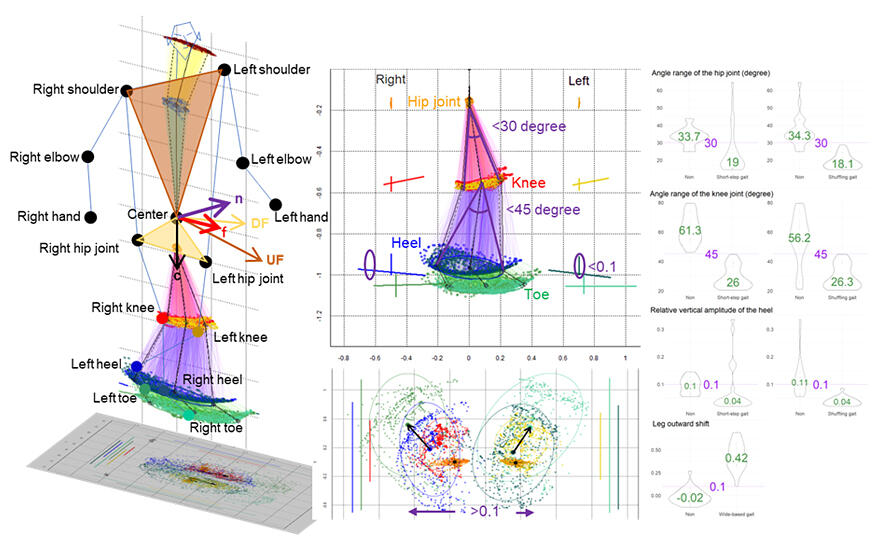A research group from Nagoya City University, Shiga University of Medical Science, Yamagata University, Digital Standard Co., Ltd., Shin‐Aikai Spine Center, and Rakuwakai Healthcare System has developed a method to convert 3D relative coordinates automatically estimated using the deep learning iPhone application TDPT‐GT into body axis‐projected 2D relative coordinates to quantitatively evaluate the pathological gaits of persons with a shuffling gait, short‐stepped gait and wide‐based gait.

Provided by Nagoya City University Hospital
A pathological gait is a gait that deviates from normal, and its features are characterized as short‐stepped, shuffling, wide‐based or spastic, with differences in gait leading to suspicion of brain disorders such as idiopathic normal pressure hydrocephalus and Parkinson's disease, spinal cord disorders such as cervical spondylosis, and different susceptibility (risk) to falls. However, the determination of pathological gait is generally done by subjective assessment by specialist doctors and physiotherapists, but the problem has been that the assessments vary between doctors.
The research group therefore used smartphones, a device almost everyone owns, and artificial intelligence (AI) to estimate 3D positional information and easily analyze 3D movements. In 3D movement analysis, the joint angles connecting each joint point are typically measured in three dimensions, but rather than evaluating the movement in three dimensions, it is simpler to project the movement of each joint point in three dimensions onto a plane that is the human body axis, like a shadowgraph, which is then projected onto the sagittal, coronal and axial sections of the body axis as 2D relative coordinates.
To determine pathological gaits, volunteers of different ages with normal gaits were asked to simulate a short‐stepped gait, a short‐stepped shuffling gait, a wide‐based short‐stepped shuffling gait, in addition to their normal gait, to search for measurements and indices that capture the characteristics of each pathological gait.
It was found that the indices for determining a shuffling gait were an average range of motion angle of the left and right hip joints of less than 30 degrees, an average range of motion angle of the left and right knee joints of less than 45 degrees and a heel rise of less than 10% of the length of the lower leg.
An indicator of a short‐stepped gait is an average range of motion angle of the left and right knee joints of less than 45 degrees. In wide‐base gaits, the sum of the left‐right horizontal lateral deviation of the center of the heel‐movement trajectory from the center of the hip‐movement trajectory (75% tolerance ellipse) on the axial section 2D projected relative coordinates of the lower leg and the left‐right horizontal lateral deviation of the center of the toe‐movement trajectory from the center of the heel‐movement trajectory was found to be more than 10% the length of the lower leg and a significant indicator.
Shigeki Yamada, Lecturer at the Nagoya City University Graduate School of Medicine, noted, "We hope that it will be possible to quantitatively assess the risk of falls easily and quantitatively, not only in hospitals but also in homes, nursing homes and anywhere else, and to detect fall risk diseases at an early stage. We expect that an app like this could be applied to telemedicine."
Journal Information
Publication: Sensors
Title: Quantitative Gait Feature Assessment on Two‐Dimensional Body Axis Projection Planes Converted from Three‐Dimensional Coordinates Estimated with a Deep Learning Smartphone App
DOI: 10.3390/s23020617
This article has been translated by JST with permission from The Science News Ltd. (https://sci-news.co.jp/). Unauthorized reproduction of the article and photographs is prohibited.




